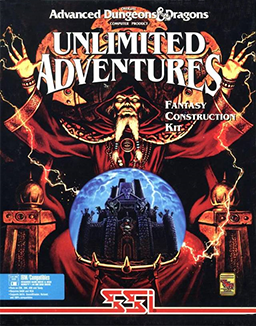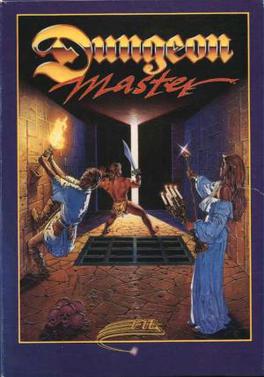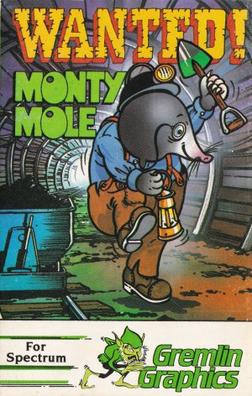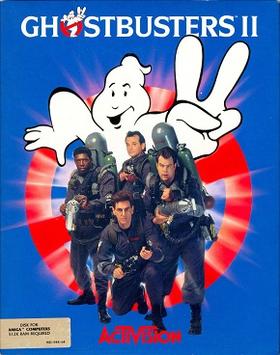
Simon the Sorcerer is a 1993 point-and-click adventure game developed and published by Adventure Soft, for Amiga and MS-DOS. The game's story focuses on a boy named Simon who is transported into a parallel universe of magic and monsters, where he embarks on a mission to become a wizard and rescue another from an evil sorcerer. The game's setting was inspired by the novels of the Discworld series, and incorporates parodies on fantasy novels and fairy tales, such as The Lord of the Rings and Jack and the Beanstalk. The lead character's design was inspired by that of the fictional British television character Blackadder, with the character voiced by Chris Barrie in the CD re-release.

Pool of Radiance is a role-playing video game developed and published by Strategic Simulations, Inc (SSI) in 1988. It was the first adaptation of TSR's Advanced Dungeons & Dragons (AD&D) fantasy role-playing game for home computers, becoming the first episode in a four-part series of D&D computer adventure games. The other games in the "Gold Box" series used the game engine pioneered in Pool of Radiance, as did later D&D titles such as the Neverwinter Nights online game. Pool of Radiance takes place in the Forgotten Realms fantasy setting, with the action centered in and around the port city of Phlan.

Forgotten Realms: Unlimited Adventures, also known as Unlimited Adventures, or by the acronyms FRUA or UA, is a video game originally released on March 17, 1993, by Strategic Simulations, for the IBM PC and Macintosh.

Prince of Persia is a cinematic platform game developed and published by Broderbund for the Apple II in 1989. It was designed and implemented by Jordan Mechner. Taking place in medieval Persia, players control an unnamed protagonist who must venture through a series of dungeons to defeat the evil Grand Vizier Jaffar and save an imprisoned princess.

Dungeon Master is a role-playing video game featuring a pseudo-3D first-person perspective. It was developed and published by FTL Games for the Atari ST in 1987, almost identical Amiga and PC (DOS) ports following in 1988 and 1992.

Commando, released as Senjō no Ōkami in Japan, is a vertically scrolling run and gun video game released by Capcom for arcades in 1985. The game was designed by Tokuro Fujiwara. It was distributed in North America by Data East, and in Europe by several companies including Capcom, Deith Leisure and Sega, S.A. SONIC. Versions were released for various home computers and video game consoles. It is unrelated to the 1985 film of the same name, which was released six months after the game.
Michael Jackson's Moonwalker is the name of several video games based on the 1988 Michael Jackson film Moonwalker. Sega developed two beat 'em ups, released in 1990; one released in arcades and another released for the Sega Genesis and Master System consoles. U.S. Gold also published various games for home computers the same year. Each of the games' plots loosely follows the "Smooth Criminal" segment of the film, in which Jackson rescues kidnapped children from the evil Mr. Big, and incorporates synthesized versions of some of the musician's songs. Following Moonwalker, Jackson collaborated with Sega on several other video games.
An interactive film is a video game or other interactive media that has characteristics of a cinematic film. In the video game industry, the term refers to a movie game, a video game that presents its gameplay in a cinematic, scripted manner, often through the use of full-motion video of either animated or live-action footage.

Wizards & Warriors, titled Densetsu no Kishi Elrond in Japan, is an action platform video game developed by Rare and published by Acclaim Entertainment for the Nintendo Entertainment System. It was released in North America in December 1987, and in Europe on January 7, 1990. The player controls Kuros, "Knight Warrior of the Books of Excalibur", as he sets out in the Kingdom of Elrond to defeat the evil wizard Malkil. Malkil holds the princess of Elrond captive in Castle IronSpire, deep within the forests of Elrond. The player fights through forests, tunnels, and caves, while collecting keys, treasure, weapons, and magic items.

Thexder is a run and gun video game from Game Arts, originally released for the NEC PC-8801 in 1985. It was ported to many systems, including the Famicom.

Wanted: Monty Mole is a platform video game published in July 1984 for the ZX Spectrum and Commodore 64 home computers. It is the first game released by Gremlin Graphics and the first game in the Monty Mole series. Monty Mole is a fictional mole created by Ian Stewart, the director of the company.

Entombed is an action-adventure video game published by Ultimate Play the Game for the Commodore 64 in 1985. It is the second instalment of the Pendragon series and is a sequel to The Staff of Karnath. The game features series protagonist and aristocrat adventurer, Sir Arthur Pendragon, as he attempts to escape an ancient Egyptian tomb before all oxygen runs out. As with its predecessor, Entombed is presented in an isometric format.

Love Story, stylized as Ø Story, is a Japanese exclusive adventure interactive movie video game developed by General Entertainment and published by Enix on April 27, 2000. It was the first Enix game published on the PlayStation 2, and was part of the campaign to promote the release of the console in Japan.

Human Killing Machine is a 2D fighting video game. The game was developed by British company Tiertex, who hired external team Blue Turtle to produce the graphics, and published by U.S. Gold, released in March 1989. It was touted as a sequel to Tiertex's home computer conversion of Street Fighter. It was released for 8-bit and 16-bit home computer formats.
Pool of Radiance is a series of role-playing video games set in the Forgotten Realms campaign settings of Dungeons & Dragons; it was the first Dungeons & Dragons video game series to be based on the Advanced Dungeons & Dragons rules.
Gangbusters is a 1982 strategy video game about the American Mafia for the Commodore 64. The game is set during Prohibition in the early 1920s. The game appeared in the December 1982 issue of The Rainbow. Due to various glitches, the game failed to work on 16K machines but worked reliably on most 32K machines. A complete set of documents were included with the game that taught the players the complete glossary of the Mafia "language."

The Real Ghostbusters is a 1987 shoot 'em up arcade game developed and published by Data East. It is loosely based on Ghostbusters. In Japan, Data East released it as a non-Ghostbusters arcade game under the title Meikyuu Hunter G. In 1989, Activision published The Real Ghostbusters for Amiga, Amstrad CPC, Atari ST, Commodore 64, and ZX Spectrum.

Through the Looking Glass, also known as Alice, is a 1984 video game written for the Apple Lisa and Apple Macintosh computers. Written by a member of the Lisa and Mac teams, Steve Capps, it was one of the earliest video games on the Mac platform, part of the only games disk officially sold by Apple Computer during that era.

Ghostbusters II is a 1989 action game based on the film of the same name. It was published by Activision for various computer platforms. British studio Foursfield developed a version for Commodore 64, Amiga, Atari ST, Amstrad CPC and ZX Spectrum, which also got ported to the MSX by New Frontier. It features three levels based on scenes from the film. Dynamix developed a separate version for the DOS, also based on the film. The non-DOS versions were praised for the graphics and audio, but criticized for long loading times, disk swapping, and the final level. The DOS, Commodore 64 and Amiga versions were the only versions released in North America.

Judge Dredd is a 1991 platform shoot 'em up video game based on the character of the same name. It was developed by Random Access and published by Virgin Mastertronic. It was released in Europe in 1991, for the Amiga, Atari ST, Commodore 64, and ZX Spectrum. Critics found the gameplay repetitive.

















